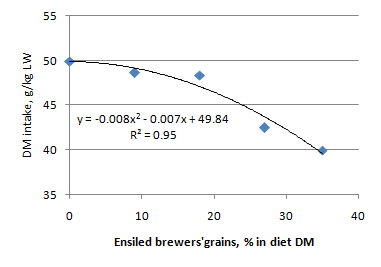|
Back to Content
|
MEKARN Conference 2010
Live
stock production, climate change and resource depletion
|
|
Ensiled
processing technique and utilization of ensiled brewer’s grain as protein source
in diets for crossbred (Large White x Mong Cai) pigs
in Central Vietnam
Nguyen Thi Loc
University of Agriculture and Forestry, Hue
city, Vienam
Abstract
The research on the
effect of additives and time on the quality of brewer’s grain silages has been
implemented in laboratories of Hue University.
The Brewer’s grain was collected from Hue
brewery factory. The brewer’s grain were ensiled in five formulas as Brewer’s
grain; Brewer’s grain with 0.5 % NaCl; Brewer’s grain with 3% molasses; Brewer’s
grain with 3% molasses and 0.5% NaCl; Brewer’s grain with Lactobacillus
Fermentum. As the result
showed that the pH of 5 ensiled formulas were 4.3 at the beginning. Ensiled
Formula of Brewer’s grain with 3%
molasses or Brewer’s grain with 3% molasses and 0.5% NaCl created a pH of
3.8 at the days of 7, 14
and 21 after ensiling. Then, pH was stable at 3.8 until 60 days of silage and
preserving time of ensiling was more than 60 days. Fomulas of
Brewer’s grain or Brewer’s grain with 0.5 % NaCl
or Brewer’s grain with 2 ml Lactobacillus Fermentum created a pH of 4.3 at the
days of 7 and 14 day after ensiling. Then pH increased to 4.8 after 21 ensiling
day and preseving time of ensiling was 14 days.
An on station trial was carried out at the Animal Research Centre of Hue
University of Agriculture and Forestry. Fifteen cross-bred (Large White x Mong
Cai) pigs at 90 days with average live weight of 20 kg was arranged randomly in
5 treatments with 3 replications.
The control diet (EBG0) consisting of rice bran, cassava root meal, fish meal
and premix. Four experimental diets EBG9,
EBG18, EBG27 and EBG35 was formulated at 0, 9, 18, 27 and 35% DM of
ensiled
Brewer’s grain.. Five diets were
formulated following 2 growing periods of pigs from 20-50 kg and 50-100 kg of
liveweight, with ME content of 3100 Kcal/kg and CP content
of 15% và 13% (based DM) respectively. There was significant differences in
liveweight gain of pigs fed these diets
(P< 0.05). The liveweight gain of pigs fed diet of 0, 9, 18, 27 and 35% EBG were
716, 702, 695, 574 and 510 g/day respectively.
There was no significant differences in FCR
between diets (P > 0.05). However, The
total feed cost between diets were significant differences (P <0.05). Feed costs
per kg live weight gain were 12-14% less for pigs fed diets including 18% and
27% Brewere’s grain comparing with control diet. There
were also no significant differences at carcass yield, the thickness of back
fatness, loin eye area and rate of lean meat (P > 0.05).
In conculusion, level of ensiled
brewer’s grain
in diet for cross-bred pigs (Large White x
Mong Cái)
at 18% and 27% DM gave reasonably high growth rates and good economic returns.
Key words: (Large
White x Móng Cái) pigs,
Brewer’s grain,
silage, additive, Performance, Carcass
Characteristics, Economics.
|
Table 1.
Effect of additive supplementation in silages process on pH
|
|
Silages |
Ensiling time |
|
0 |
7 |
14 |
21 |
|
B |
4.23a |
4.54a |
4.12a |
4.8 |
|
BS |
4.26a |
4.11b |
4.10a |
4.7 |
|
BM |
4.37b |
4.43c |
3.80b |
3.78a |
|
BMS |
4.24a |
3.70d |
3.62c |
3.84b |
|
BL |
4.28a |
4.39e |
4.34d |
4.9 |
|
SEM/Prob |
0.02/0.01 |
0.01/0.01 |
0.01/0.01 |
0.01/0.01 |
 |
 |
| Figure 1. Effect of replacing rice bran and fish meal by
ensiled brewers' grains on DM intake |
Figure 2. Effect of replacing rice bran and fish meal by
ensiled brewers' grains on weight gain |
|

